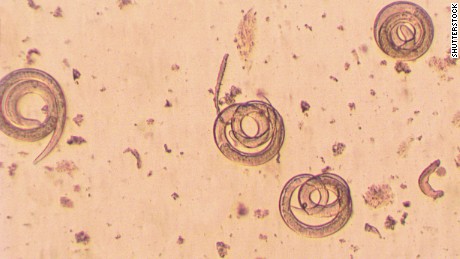Story highlights
- Tapeworms and other parasites can have dangerous and deadly health implications for humans
- Toxoplasmosis infects more than a million people each year in the U.S.
(CNN)Prepare yourself. The gross out factor of this one is beyond puke level: Doctors In Napa, California, found a tapeworm in a man's brain that nearly killed him.
Just a few days earlier, a CDC researcher announced in the New England Journal of Medicine that another man's lung cancer was caused by the cancer of his tapeworm.
That's right. The worst headache of Luis Ortiz's life was due to a "wiggling" tapeworm surgeons found inside a cyst inside his brain. The cyst was successfully removed, and Ortiz is making a full recovery.
A Colombian man was not so lucky. The cancerous lung tumors that killed him in 2013 came from a tapeworm that had been living in his HIV-compromised system. When that tapeworm developed cancer, its cells spread into his body and grew there.
Are these just two very sad (and gross) coincidences? It's actually scarier than that. There are at least four other equally disturbing parasites to worry about, some more common than you think.
Cat-scratch fever, aka Toxoplasmosis, aka T. gondii
Toxoplasmosis infects more than a million people each year in the U.S. Once you get it, you've usually got it for life, according to the Centers for Disease Control.
It's caused by a parasite we ingest called Toxoplasma gondii that travels through the walls of our intestines to muscles and major organs, and can cause fever and malaise, eye disease, and in immune compromised individuals, it can kill. An infection during pregnancy can cause miscarriage and severe disease in newborns; there are up to 4,000 cases of mother-to-child transmissions each year.
Because cats are a common host, it's often called cat-scratch fever, but you actually get it by ingesting the parasite after cleaning a cat box, or eating anything contaminated by cat feces, such as food from a home garden where your cat likes to potty. You can also get it from eating raw or undercooked meat.
Roundworm, aka Toxocariasis, aka T. canis and T. cati
Don't gloat, cat-haters, dogs can also carry the parasite. It's caused by the larval form of the roundworms that infect cats and dogs, even when they are young. Called Toxocara canis in dogs and Toxocara cati in cats, the roundworm eggs are excreted in feces, and if you (or your child) accidentally ingests it, usually by eating something with infected dirt,the eggs will travel to organs and tissues, hatch and do their thing. While not common, it's bad: The CDC says each year 70 people, mostly children, are blinded by the disease.
Trichomoniasis, aka T. vaginalis
This STD is caused by the Trichomonas vaginalis parasite, and the CDC says it's the most commonly curable sexually transmitted disease out there. Nearly 3.7 million Americans are infected, and 70% don't have any signs or symptoms, so they may not even know they are constantly passing it along. That may be part of the reason another million people are newly infected each year.
Symptoms, when they appear, include burning during urination, redness, soreness or itching of the genitals, or perhaps a discharge. It's treatable with antimicrobial medications from your doctor, but you can easily become re-infected -- another good reason to practice safe sex.
Chagas disease, aka T. cruzi
This disease comes from a bug called a triatomine that's infected with the Trypanosoma cruzi parasite. It's found in Mexico and Central and South America, so it mostly affects those who have visited those areas or emigrated from those regions.
The CDC estimates there are at least 300,000 people living with the disease in the U.S. right now, but many don't know it. It unusually takes years of chronic infection before symptoms such as heart disease, heart failure and gastrointestinal problems begin.
Tapeworm, aka Neurocysticercosis, aka T. solium
Remember that "wiggling" worm inside Luis Ortiz's brain? Well, it's not a sci-fi horror flick (you know, like "Alien," where the thing rips through his belly). Larval cysts like Ortiz's are caused by the immature stage of a pork tapeworm called Taenia solium. They can infect all parts of the body, but when they infect the brain it's called neurocysticercosis.
What's really gross: the CDC says about 1,000 people a year get the infection from eating something containing "microscopic eggs passed in the feces of a person who has an intestinal pork tapeworm."
While this is most common in Latin America, the lesson here is to not eat undercooked pork, where the eggs may live, and always wash your hands. The really scary part: Did that person making your food do the same?























